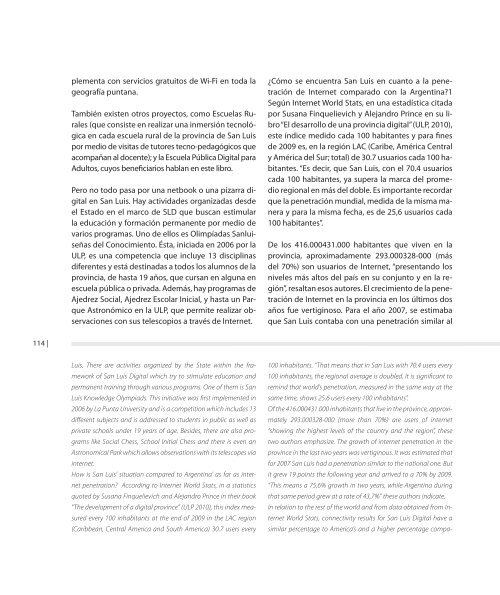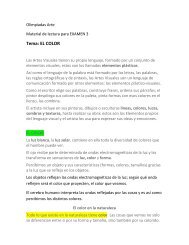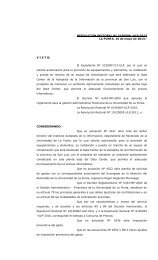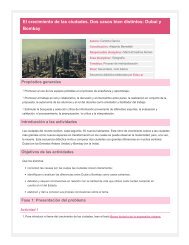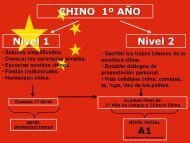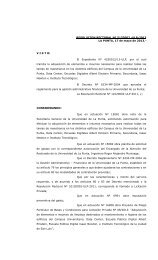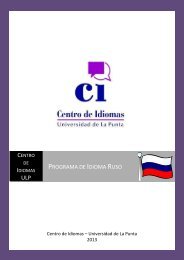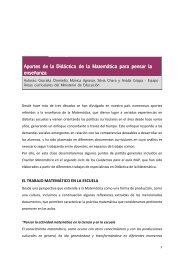e-Book PDF - Universidad de La Punta (ULP)
e-Book PDF - Universidad de La Punta (ULP)
e-Book PDF - Universidad de La Punta (ULP)
You also want an ePaper? Increase the reach of your titles
YUMPU automatically turns print PDFs into web optimized ePapers that Google loves.
plementa con servicios gratuitos <strong>de</strong> Wi-Fi en toda lageografía puntana.También existen otros proyectos, como Escuelas Rurales(que consiste en realizar una inmersión tecnológicaen cada escuela rural <strong>de</strong> la provincia <strong>de</strong> San Luispor medio <strong>de</strong> visitas <strong>de</strong> tutores tecno-pedagógicos queacompañan al docente); y la Escuela Pública Digital paraAdultos, cuyos beneficiarios hablan en este libro.Pero no todo pasa por una netbook o una pizarra digitalen San Luis. Hay activida<strong>de</strong>s organizadas <strong>de</strong>s<strong>de</strong>el Estado en el marco <strong>de</strong> SLD que buscan estimularla educación y formación permanente por medio <strong>de</strong>varios programas. Uno <strong>de</strong> ellos es Olimpíadas Sanluiseñas<strong>de</strong>l Conocimiento. Ésta, iniciada en 2006 por la<strong>ULP</strong>, es una competencia que incluye 13 disciplinasdiferentes y está <strong>de</strong>stinadas a todos los alumnos <strong>de</strong> laprovincia, <strong>de</strong> hasta 19 años, que cursan en alguna enescuela pública o privada. A<strong>de</strong>más, hay programas <strong>de</strong>Ajedrez Social, Ajedrez Escolar Inicial, y hasta un ParqueAstronómico en la <strong>ULP</strong>, que permite realizar observacionescon sus telescopios a través <strong>de</strong> Internet.¿Cómo se encuentra San Luis en cuanto a la penetración<strong>de</strong> Internet comparado con la Argentina?1Según Internet World Stats, en una estadística citadapor Susana Finquelievich y Alejandro Prince en su libro“El <strong>de</strong>sarrollo <strong>de</strong> una provincia digital” (<strong>ULP</strong>, 2010),este índice medido cada 100 habitantes y para fines<strong>de</strong> 2009 es, en la región LAC (Caribe, América Centraly América <strong>de</strong>l Sur; total) <strong>de</strong> 30.7 usuarios cada 100 habitantes.“Es <strong>de</strong>cir, que San Luis, con el 70.4 usuarioscada 100 habitantes, ya supera la marca <strong>de</strong>l promedioregional en más <strong>de</strong>l doble. Es importante recordarque la penetración mundial, medida <strong>de</strong> la misma maneray para la misma fecha, es <strong>de</strong> 25,6 usuarios cada100 habitantes”.De los 416.000431.000 habitantes que viven en laprovincia, aproximadamente 293.000328-000 (más<strong>de</strong>l 70%) son usuarios <strong>de</strong> Internet, “presentando losniveles más altos <strong>de</strong>l país en su conjunto y en la región”,resaltan esos autores. El crecimiento <strong>de</strong> la penetración<strong>de</strong> Internet en la provincia en los últimos dosaños fue vertiginoso. Para el año 2007, se estimabaque San Luis contaba con una penetración similar al114 |Luis. There are activities organized by the State within the frameworkof San Luis Digital which try to stimulate education andpermanent training through various programs. One of them is SanLuis Knowledge Olympiads. This initiative was first implemented in2006 by <strong>La</strong> <strong>Punta</strong> University and is a competition which inclu<strong>de</strong>s 13different subjects and is addressed to stu<strong>de</strong>nts in public as well asprivate schools un<strong>de</strong>r 19 years of age. Besi<strong>de</strong>s, there are also programslike Social Chess, School Initial Chess and there is even anAstronomical Park which allows observations with its telescopes viainternet.How is San Luis’ situation compared to Argentina’ as far as internetpenetration? According to Internet World Stats, in a statisticsquoted by Susana Finquelievich and Alejandro Prince in their book“The <strong>de</strong>velopment of a digital province” (<strong>ULP</strong> 2010), this in<strong>de</strong>x measure<strong>de</strong>very 100 inhabitants at the end of 2009 in the LAC region(Caribbean, Central America and South America) 30.7 users every100 inhabitants. “That means that in San Luis with 70.4 users every100 inhabitants, the regional average is doubled. It is significant toremind that world’s penetration, measured in the same way at thesame time, shows 25.6 users every 100 inhabitants”.Of the 416.000431.000 inhabitants that live in the province, approximately293.000328-000 (more than 70%) are users of internet“showing the highest levels of the country and the region”, thesetwo authors emphasize. The growth of internet penetration in theprovince in the last two years was vertiginous. It was estimated thatfor 2007 San Luis had a penetration similar to the national one. Butit grew 19 points the following year and arrived to a 70% by 2009.“This means a 75,6% growth in two years, while Argentina duringthat same period grew at a rate of 43,7%” these authors indicate.In relation to the rest of the world and from data obtained from InternetWorld Stats, connectivity results for San Luis Digital have asimilar percentage to America’s and a higher percentage compa-


